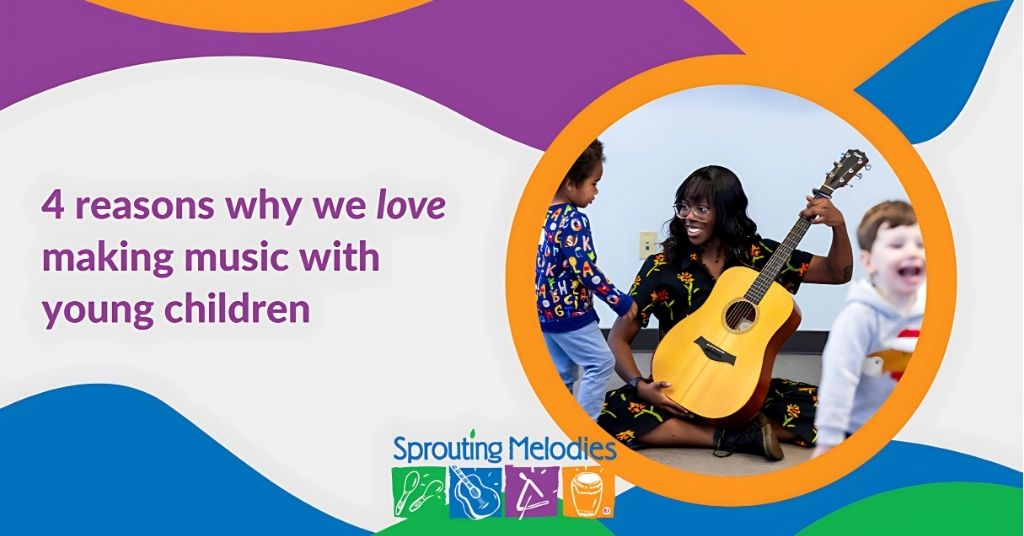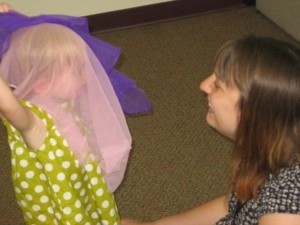Musical composition can match developmental goals and brain activity. – Sprouting Melodies
Text of this article also provided below….
From early beginnings in the womb until the late stages of adulthood, music plays an important role in human growth, development, and sustainment. Music— to be defined here as organized sound— is an essential component of most cultures, coloring the world through melodies, harmonies, rhythm, and lyrics. Humans use music as a form of emotional expression, as well as a group bonding activity through participation in orchestras, bands, and casual gatherings. Most recently, psychological researchers have been interested to find that music has another, potentially even more important function: it can improve brain development. In several experiments conducted regarding this phenomenon, statistics show that children who play instruments and possess the ability to read music tend to score higher on achievement tests (Costa-Giomi, 1999). Also, brains of adult musicians are significantly different in structure and function than those of non-musicians (Schlaug, Norton, Overy, & Winner, 2005). The results of various studies and observations concluded that both playing and listening to music positively effect brain development; however, there is still some dispute among professionals as to the validity of this statement.
Music’s effect on the human brain begins weeks before birth. Because the ability to hear is developed inside the womb, babies can hear sounds prior to exposure to the outside world. The soft timbre of a mother’s voice is one of the first recognizable noises a child hears. The child associates this sound with comfort, and will continue to remember and identify the mother’s voice as such after birth. This same concept may be applied to music. Any sort of musical sounds that a child is exposed to while in the womb— such as songs sung by the mother, musical instruments played by the mother, or music in the mother’s particular surrounding environment— may be remembered by the child and effect their progress (Hepper & Shahidullah, 1994). Though early exposure to music can not be proven to impact human brain development, research has been conducted on rats that seem to validate this hypothesis. Rats exposed in utero plus sixty days postpartum to the Mozart sonata (K.448) navigated a spatial maze faster and with fewer errors than did animals exposed to minimalist music, white noise, or silence (Rauscher & Shaw, 1998). Thus, it is quite possible that neural processes are effected by exposure to music, but there is not enough evidence to fully support this claim.
One could then further this question by asking, does listening to music through various stages of development (preschool years, middle to late childhood) have any impact? More studies have been conducted regarding childhood listening; more specifically, a phenomenon coined “the Mozart effect.” Explored by psychologists Frances Rauscher and Gordon Shaw, the “Mozart effect” suggests that listening to classical music may create short-term improvement in mental processes known as spatial-temporal reasoning. The results of this study however, were largely misinterpreted by the public, who falsely began believing that “listening to music makes kids smarter.” While Rauscher and Gordon did observe improvements on abstract spatial reasoning tests after the children were primed with a Mozart sonata, these positive effects lasted no longer than fifteen minutes. Because there was no brain alteration and the effects were temporary, the Mozart effect can not be credited with improving IQ or creating lasting change (Rauscher, Gordon, & Ky, 1993).
Although listening to music may not be directly linked to brain development, there have been studies to prove playing music might be. The act of playing an instrument involves motor skills, coordination, and complex mathematical processing, as well as psychological/emotional skills such as patience, determination, and self-expression. Musical training can assist a child’s development in the school environment specifically in the departments of mathematics and language. Understanding note values, counting out rhythms, and being able to keep a steady meter all involve uses of mathematical concepts; interpreting positions of notes on the staff and meanings of various musical symbols of embellishment parallels to reading a different language. Students are able to apply these concepts to their school work. In addition, reading music and playing an instrument can increase a child’s creativity, memory, and sense of self-worth (Schlaug, Norton, Overy, & Winner, 2005.)
In order to prove the influence of instrumental training on cognitive brain development, Gottfried Schaug, Andrea Norton, Katie Overy, and Ellen Winner conducted experiments on groups of children (fifty in total) between the ages of five and seven and between the ages of nine and eleven. Each child in the five to seven-year-old category had no previous musical background; half of them would take lessons for a year, the others would not. Children took several behavioral and intelligence tests prior to beginning music lessons (including the Object Assembly, Block Design, and Vocabulary subtests from either the Wechsler Intelligence Scale for Children (WISC-III) (for children six years and older) or the Wechsler Preschool and Primary Scale of Intelligence (WPPSI-III) (for children under age six); the Raven’s Colored Progressive Matrices (CPM) and Raven’s Standard Progressive Matrices (SPM); the Auditory Analysis Test as a measure of phonemic awareness; Gordon’s Primary Measures of Music Audiation (PMMA) as a measure of musical skill/aptitude; and two motor tests to measure speed and dexterity in both right and left hands). They also underwent structural and functional MRI brain scans. A year later, the same tests were taken, revealing improvements among the musical participants. No significant change was noted among the non-musical control group. In the nine to eleven-year-old study, researchers compared children with four years of musical experience to a group of non-instrumentalists. Musical children scored higher on some of the tests— specifically fine motor skills and auditory discrimination skills— but showed no notable differences on standard IQ tests. The instrumentalists did, however, have significantly more gray matter volume pronounced in the sensorimotor cortex and the occipital lobe bilateral. (Schlaug, Norton, Overy, & Winner, 2005.)
Schlaug, Norton, Overy, and Winner also performed cross-sectional studies among nonmusical versus musical adults, finding “significantly more gray matter in several brain regions, including the primary sensorimotor cortex, the adjacent superior premotor and anterior superior parietal cortex, primary auditory cortex, the cerebellum, the inferior frontal gyrus, and part of the lateral inferior temporal lobe” of the musicians. (Schlaug, Norton, Overy, & Winner, 2005.)
Despite the results of Schlaug, Norton, Overy, and Winner’s experiment, other researchers still claim that there is not enough solid evidence on this topic. The construct validity of the test can be disputed due to subject variables— variables that characterize pre-existing differences among study participants. Psychologists argue that the brains of subjects who undertake and persist in music lessons might originally differ from those who have no interest or do not have the persistence to continue lessons. Statistics also show that the typical piano student comes from a white, middle-upper class, and thusprivileged environment (Costa-Giomi, 1999). Because of this, these children tend to have more involved and encouraging parents, as well as the opportunity to attend better schools. Therefore, though studies show a correlation between musical lessons and intelligence, there is no evidence that music is thecausation.
Various studies have demonstrated the positive effects of both listening and playing music on brain development. These effects include improved visual-spatial, linguistic, and mathematical performance, in addition to increased memory, emotional development, and self-esteem. Structural and functional differences in the brains of adult musicians compared to adult non-musicians have also been observed. The contributions of nature and nurture to this phenomenon are not yet clear, however. Psychologists debate whether or not these experimental results are predispositional or due to other factors such as instructional methods, environment, and parenting.
References
Rauscher, F. & Shaw, G. (1998). Key Components of the Mozart Effect. Perceptual and Motor Skills, 86, 835-841. Retrieved from https://journals.sagepub.com/doi/10.2466/pms.1998.86.3.835
Schlaug, G., Norton, A., Overy, K., & Winner, E. (2005). Effects of Music Training on the Child’s Brain and Cognitive Development. The Neurosciences and Music II: From Perception to Performance, 1060, 219-230. doi: 10.1196/annals.1360.015
Costa-Giomi, E. (1999). The Effects of Three Years of Piano Instruction on Children’s Cognitive Development. Journal of Research in Music Education, 47, 198-212. Retrieved from https://www.jstor.org/stable/3345779
Hepper, P. & Shahidullah, S. (1994). Development of Fetal Hearing. Archives of Disease in Childhood, 71, F81-F87. Retrieved from https://www.realpeacework-akademie.info/graz/e/eScience/music.pdf



 There is nothing like sharing in the simplicity of music making with a child. As a newborn, music is a profound experience that causes the baby to stop and look around, waiting and watching. As children age, they become more and more aware of the environment and still attend to music as if it is a huge presence in the room. I learn a lot from their experience of music.
There is nothing like sharing in the simplicity of music making with a child. As a newborn, music is a profound experience that causes the baby to stop and look around, waiting and watching. As children age, they become more and more aware of the environment and still attend to music as if it is a huge presence in the room. I learn a lot from their experience of music. There is a closeness in making music with your child that goes beyond a song. It is our common understanding that songs and lullabies create intimate shared moments for babies and caregivers. With repetition, those shared musical moments create meaningful bonds.
There is a closeness in making music with your child that goes beyond a song. It is our common understanding that songs and lullabies create intimate shared moments for babies and caregivers. With repetition, those shared musical moments create meaningful bonds.